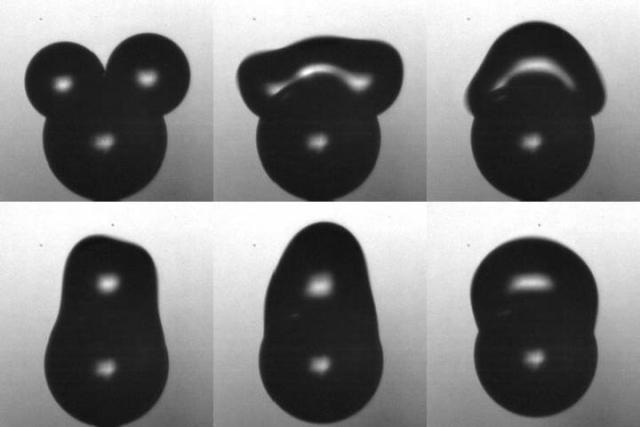Jul 6 2016
Self-cleaning, hydrophobic surfaces are highly appealing. Imagine airplane wings that de-ice themselves, scalpels that do not require washing, and windshields that easily repel raindrops. The downside is that the nanostructures in these water-repelling surfaces are highly fragile in nature, which seriously limits the resilience and application of such objects. A team of researchers from Duke University in Durham, North Carolina, and the University of British Columbia in Vancouver, Canada, have come up with a solution.
 Coalescence of two water drops on a polystyrene particle leads to the launching of the particle away from the supporting substrate. This figure is the same as the cover image for the July 4th issue, and is adapted from Figure 2a of the paper. (Photo credit: Roger L. Chavez/Duke University)
Coalescence of two water drops on a polystyrene particle leads to the launching of the particle away from the supporting substrate. This figure is the same as the cover image for the July 4th issue, and is adapted from Figure 2a of the paper. (Photo credit: Roger L. Chavez/Duke University)
The research team is involved in exploring the mechanisms of self-propulsion that happen when two droplets combine, propelling themselves and any probable contaminants off the surface of interest.
They eventually aim to establish whether superhydrophobicity, a surface that cannot be made wet is an essential necessity for self-cleaning surfaces.
“The self-propelled catapulting process is somewhat analogous to pogo jumping,” said Chuan-Hua Chen, an associate professor in the Department of Mechanical Engineering and Materials Science at Duke University. He and his colleagues published their research in Applied Physics Letters, from AIP Publishing.
When the droplets combine on a solid particle, they discharge energy in the same way that a human body discharges biochemical energy when on a pogo stick.
The energy is subsequently converted via the interaction between the solid particle and the oscillating liquid drop - similar to the storage and conversion of energy by the pogo stick’s spring mechanism.
In both cases, the catapulting is produced by internally generated energy, and the ultimate launching comes from the ground that supports the payload - the solid particle or the pogo stick.
Chen
The team had earlier experimented with self-propelled jumping droplets set off by drop coalescence on superhydrophobic surfaces. According to Chen, he and his colleagues primarily ran into difficulties with illustrating the same self-propelled movement without a superhydrophobic surface.
The solution suddenly occurred to us while we were examining the drop coalescence process with numerical simulations by my student Fangjie Liu. The coalescence of two droplets on a particle can provide the source of energy to catapult the particle, much like pogo jumping. Guided by this insight, another student, Roger Chavez, inkjet-printed two droplets on a solid particle, which rests on a supporting substrate. As the droplets coalesce, the merged drop not only jumps away from the supporting substrate, but also carries the solid particle along with it.
Chen
Since neither the solid particle nor the supporting substrate is superhydrophobic, we clearly demonstrated the feasibility of coalescence-induced self-cleaning without resorting to superhydrophobic surfaces.
Chen
Besides self-cleaning engineering systems, Chen and his colleagues will also be creating laboratory models for an associated phenomenon - ballistospore launch set off by drop coalescence on fungal spores. This has been noticed on several fungi species, but in the past has only been explored on live spores.